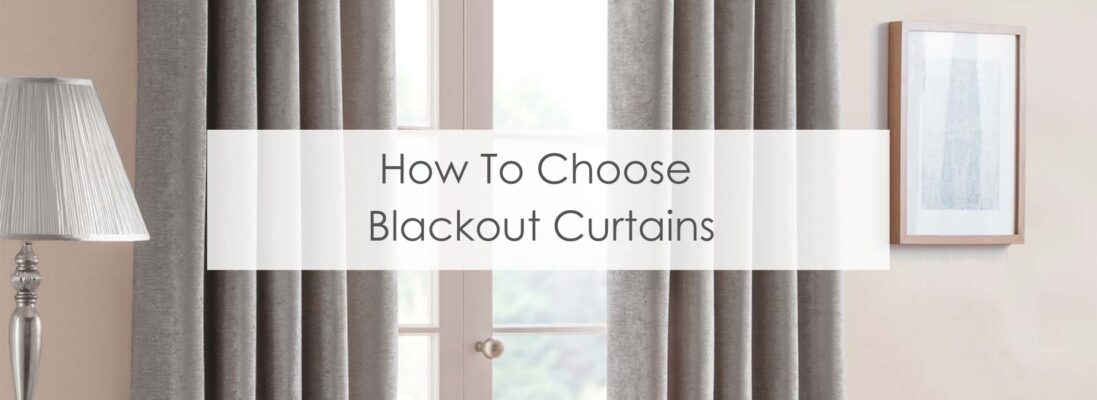Home Improvement
How to Choose and Install Blackout Curtains for Your Home
How to Choose and Install Blackout Curtains for Your Home

Choosing the right blackout curtains is an important decision for any home that requires optimal light control. Whether you need darkness for sleep, focus or privacy, this guide will help you understand blackout curtain options, select the best fabric and style for your needs, properly measure and install curtains, and care for them to maintain maximum light blocking performance. Read on to unlock the hidden benefits of blackout curtains.
What are blackout curtains?
Blackout curtains are a specific type of window covering designed to block external light from entering a room. Unlike regular curtains or blinds which allow some amount of light to pass through, blackout curtains eliminate almost all light transmission. They are made with extremely thick and dense fabrics like velvet, microfiber, cotton, or thermal polyester that prevent sunlight or artificial lights outside from shining through.
Some key characteristics of blackout curtain fabrics include their ability to absorb incoming light rays rather than reflecting them. Fabrics may also have a heavy weave structure or flocking added to the backside to increase opacity. Many popular options on the market claim to achieve over 99% blackout effects. While most regular curtains only block 50-70% of outside light, fabrics designed for blackouts can render a room almost completely dark during the daytime.
Custom blackout curtains have become a popular choice for bedrooms that need optimal light control. They help create ideal sleeping conditions by allowing users to set their own daytime versus nighttime lighting environment. Some additional spaces that benefit from blackout treatments include home theaters, nurseries, and artist studios where consistent lighting is important.
Benefits of Using Blackout Curtains
There are several advantages to installing blackout curtains in both residential and commercial settings:
- Improved Sleep – By completely blocking out sunlight, blackouts can make it much easier to sleep through the day if you work night shifts or need daytime rest. This allows your body’s circadian rhythm to better adjust.
- Energy Efficiency – Blackout fabrics help insulate against heat transfer between seasons. They reduce the need for air conditioning and heating during extreme outdoor temperatures, lowering year-round utility bills.
- Privacy Control – Thick blackout materials make it nearly impossible to see inside rooms from the outside even during bright daylight, increasing security and preventing visual disturbances.
- Light Sensitivity – Certain medical conditions like chronic migraines can be triggered by strong light levels. Blackouts provide relief indoors without missing out on natural daylight when you need or want it.
- Focus and Productivity – Complete light blocking with blackouts supports focus and mental clarity for activities requiring deep concentration like studying, analyzing data or artwork, video gaming, and film or TV production.
Choosing the Right Fabric and Style
When selecting blackout curtains, the first step is determining your light-blocking needs based on room orientation and purpose. Then factors like aesthetics, budget, and easy care also influence material and style decisions:
- Fabric Composition – 100% cotton, microfiber, and velvet materials perform best but can be more expensive. Thermal polyester blends also provide insulation at lower costs.
- Weave Density – Heavier, more closed weaves like twill or sateen are best for blocking light versus sheerer open weaves like cheesecloth.
- Backing or Lining – Blackout curtains with flocking, thermal backing, or blackout lining offer enhanced opacity versus a single layer of fabric.
- Panel Lengths – Floor-length options cover more window area than knee-high or hip-height styles for increased blocking ability.
- Hardware Compatibility – Consider whether you need blackout curtains mounted on rods, tracks or as Roman shades for full coverage.
Styles may include causal café curtains, elegant ruffled panels, or tidy tailored looks depending on your design tastes. Blackout linings can also be added to existing curtain panels for an easier update. Test swatches in different lighting before purchasing to verify opacity levels meet your needs.
Measuring Your Windows for Blackout Curtains
Proper measurement ensures your blackout curtains fit the windows correctly without gaps to maintain optimal light blocking. To measure:
- Width – Measure across the entire window casing or frame from one side to the other including any obstructions. Add 4-6 inches total for overlap and full coverage.
- Length – For floor-length styles, measure from the top of the window opening down to the floor or desired hem length stopping 1-2 inches above baseboards. For shorter styles, measure window opening height instead.
- Rod Pocket Depth – If mounting on a rod pocket curtains, add 5-8 inches total to the width for fullness and cascading folds.
Record all measurements and double check before ordering custom sizes. Standard sizes may require hemming for accuracy but purchasing a few extra inches allows for mistakes without having to reorder.
Selecting the Right Curtain Hardware
To achieve the full insulating and light-blocking capabilities of blackout curtains, it’s important the panels are mounted correctly using hardware proportional to your window sizes:
- Curtain Rods – Go for a heavier 1-inch diameter rod strong enough to support thick fabrics without bowing. Opt for fixed or sliding brackets appropriate for your window type.
- Blackout Track Systems – Integrated tracks designed for blackouts allow for light-tight fitting and easy opening/closing. They provide improved insulation versus rear window gaps with rods.
- Top-Down/Bottom-Up Options – Draw-style hardware controls light entry from the top or bottom only leaving one area light-sealed when partially open.
- Grommets or Rings – Blackout rods require compatible grommets or rings spaced every 8-10 inches along the panel heading.
Test rods by securing one end and simulating full load weight to prevent future sagging or breaks from heavy materials over time. Mounting height should allow for adequate clearance when fully gathered.
Step-by-Step Guide to Installing Blackout Curtains
To properly install blackout curtains:
- Measure and record all window sizes as outlined above then cut fabric panels to precise lengths.
- Attach grommets, rings or rod pockets evenly spaced along each panel top heading using a ladder or table for stability.
- Mount selected rod or track hardware level at the proper height using supports and secure screws through window framing or the wall above. Brackets should face outward.
- Slide each panel onto the rod through the grommets, rings or pocket opening. Space evenly with desired overlapping.
- Trace the rod mounting position onto the wall and affix any side brackets for rotational supports.
- Adjust panels as needed so they move smoothly along the rod without bunches or gaps when open/closed. Test for full light blocking ability.
- For insulation, also consider adding a blackout lining behind standard curtains. Hem longer panels to avoid tripping hazards.
Tips for Maximizing Light Blocking and Insulation
A few extra steps when installing or using back tab blackout curtains can boost their light-control and energy-saving performance:
- Add Back Tab – Affixing the black backing material along the panel’s top heading creates a light-tight fit against the window when drawn.
- Overlap Panels – Arrange two full panels per window with a generous 6-inch overlap in the middle for redundancy.
- Ensure a Smooth Fit – Gently pushing the fabric into any window cracks or crevices prevents light leakage around edges.
- Use in Combination – Layer blackout curtains with blinds, shades or shutters for enhanced shielding from multi-directional light sources.
- Draw All the Way – Be sure to pull blackouts fully closed with no untucked areas when complete coverage is required.
- Caulk and Weatherstrip Windows – Seal any exterior gaps where air could enter or exit to maximize a room’s insulation ability.
Maintaining and Cleaning Blackout Curtains
To keep blackout curtains looking their best:
- Dust Regularly – Use a soft feather duster or vacuum attachment meant for delicate fabrics to remove dust buildup.
- Spot Clean Spills – Act quickly by sponging liquid spills with a mixture of water and gentle detergent then allowing to air dry fully.
- Machine Wash Delicates – Remove hardware and launder blackout curtains in a mesh bag on a gentle or delicate cold cycle. Line dry.
- Rotate Annually – Swap positions of panels every 6-12 months to promote even fading from sunlight.
- Use Curtain Care Products – Specialized foam or liquid treatments can help maintain the softness and light-blocking performance of blackout fabrics over time.
The key things to remember are properly measuring, securely mounting hardware, properly overlapping panels, and regularly maintaining blackout curtains for optimum functionality in blocking light, providing insulation and enhancing privacy as needed. With the right fabric, style and installation, they can transform any room quickly and easily.
Home Improvement
Reasons to Hire Professional Junk Removal for Your Home Renovation

Embarking on a home renovation project can be an exhilarating yet daunting process, with many homeowners overlooking the inevitable accumulation of debris and unwanted materials. Efficient junk removal is a crucial component of a successful renovation, ensuring your work area is safe and clutter-free. Whether tearing down walls or updating fixtures, the waste generated can quickly become overwhelming. Professional junk removal companies provide the necessary means to keep your renovation organized and on track. Below, we explore the benefits of enlisting expert services for your home cleanout tasks.
Ensuring Safety and Compliance with Professional Junk Removal
Renovation projects can create hazardous environments if waste is not managed properly. Sharp debris, heavy materials, and potentially dangerous substances all pose serious safety risks. Hiring professionals for junk removal ensures these threats are handled correctly, reducing the chance of accidents or injuries.
Beyond safety, proper disposal is essential to stay compliant with local laws. Companies offering junk removal in Fort Collins, CO, are familiar with state and municipal regulations, use the right equipment and techniques to remove waste responsibly. Their services reflect a strong commitment to both safety and environmental care.
The Importance of Efficient Debris and Junk Removal During Home Renovations
Home renovations often produce large amounts of waste, including construction debris, old appliances, and personal items. If not properly managed, this clutter can hinder workflow, delay progress, and create safety hazards for contractors. Maintaining a clean and organized site is key to keeping renovations efficient and on schedule.
Professional junk removal services play a vital role by regularly clearing debris, allowing work to continue without interruption. These services also sort materials for recycling or donation, minimizing environmental impact. For homeowners, handling debris alone can be overwhelming and time-consuming, making professional help a practical choice that eases the burden and supports a smoother renovation process.
Streamlining Your Renovation Project with Professional Junk Hauling Services
Integrating professional junk hauling services into a renovation plan helps streamline operations by allowing construction teams to concentrate on building tasks without the distraction of waste removal. These services bring the necessary equipment and expertise to handle heavy or awkward debris efficiently, reducing strain on renovation crews.
A structured disposal approach also aids in cost control, as many companies provide upfront pricing based on volume or material type, helping homeowners avoid unexpected expenses. Junk removal teams ensure safe, efficient handling of discarded materials, maintaining workflow and project timelines. Their involvement supports a cleaner, safer site and allows homeowners to focus on design choices rather than logistics.
Enhancing Your Home’s Aesthetics and Value through Expert Cleanout Solutions
A clean, well-maintained renovation site significantly enhances both the visual appeal and efficiency of a project. Clutter and debris not only disrupt progress but also diminish the workspace’s appearance. Professional junk removal services help maintain order by promptly clearing waste, highlighting the renovation’s progress.
The property’s exterior also benefits, as a tidy environment boosts curb appeal and suggests careful project management, positively influencing perceived value. Removing old or unused items creates more functional space, making it easier to plan and implement design changes. This organized approach also supports long-term upkeep by encouraging homeowners to maintain a clean and well-managed space beyond the renovation phase.
Choosing the Right Junk Removal Company for Your Renovation Needs
Choosing the right junk removal service during a renovation requires careful consideration. Research a company’s experience, customer feedback, and whether they specialize in construction debris, as this can lead to better service tailored to renovation needs. Look for providers with clear pricing and free on-site estimates to avoid unexpected charges.
Evaluate their environmental practices; companies that focus on recycling and donation over dumping contribute positively to sustainability. It’s also important to assess their availability and flexibility, since renovation schedules often change. A provider that can adapt and offer prompt service helps keep the project on track without unnecessary delays.
Altogether, hiring a professional junk removal service for your home renovation project delivers numerous advantages, ranging from enhanced safety and efficiency to compliance and aesthetics. By selecting the right service provider, homeowners can streamline their renovation process and achieve a clutter-free, valuable outcome for their property.
READ ALSO: Save Time and Stress: The Advantage of Professional Junk Removal
Home Improvement
How Junk Removal Services Can Help with Home Renovations

Embarking on a home renovation can be an exhilarating endeavor that breathes new life into your living space. Amidst the excitement and planning, the accumulation of debris and old materials can become an overwhelming byproduct. Fortunately, professional junk removal services play a crucial role in maintaining the cleanliness and organization necessary for a successful renovation. They efficiently strip away the clutter, enabling homeowners to focus on the transformative process. Below, we’ll explore how these services can be integral to your next home improvement project.
Maximizing Space and Minimizing Stress: The Benefits of Professional Junk Hauling
Junk hauling services play a vital role in streamlining home renovations. By clearing out old fixtures, furniture, and debris, they free up valuable space needed for contractors and designers to work efficiently. This space optimization helps keep the renovation on track and allows the vision to take shape without clutter getting in the way.
Beyond just clearing space, professional junk removal in Austin, TX, can ease the emotional and financial strain on homeowners. Quick debris removal reduces stress, speeds up the renovation timeline, and often proves more cost-effective than DIY disposal. With less mess and more progress, homeowners can get back to enjoying their space sooner.
The Role of Junk Removal in Streamlining Home Renovation Projects
Junk removal services are essential during home renovations, helping to maintain a clean worksite and keep the project on schedule. They handle bulky items like old appliances and cabinetry, reducing physical strain on homeowners and renovation teams. These professionals also handle hazardous materials like asbestos or lead-laced paint, adhering to best practices to protect health and ensure regulatory compliance.
The prompt removal of debris by a professional team is reassuring for homeowners, as they can trust their property will be treated with respect and renovation will proceed without unnecessary hindrances caused by accumulated debris. Trusting these professionals ensures a smooth and efficient renovation process.
Enhancing Safety and Efficiency During Renovations Through Debris Removal
Junk removal services are crucial for safety and efficiency on renovation sites, as they help remove hazards like sharp objects, nails, and splintered materials. This reduces the risk of accidents and injuries. Cluttered spaces can impede workflow and extend project timelines, but junk removal experts ensure workers can move freely, allowing for timely completion.
They can handle large-scale waste removal, ensuring no delays in waste management. Professional debris removal also maintains the property’s aesthetic, as it helps maintain neighborhood standards and property values.
How Junk Removal Services Complement Contractor Work on Home Renovation Sites
Contractors can improve the efficiency of home renovations by partnering with junk removal services. Contractors, skilled in construction, electrical work, and plumbing, can’t specialize in waste management. Hiring a junk removal service allows them to focus on their craft without being distracted by cleanup duties.
This synergy leads to a seamless transition from demolition to reconstruction. Junk removal services also offer flexibility, allowing them to adapt to unexpected challenges and changes in waste disposal needs. This ensures that waste is handled responsibly and in compliance with regulations, providing liability protection and avoiding potential penalties or fines.
Transforming Renovation Waste Into Opportunity: Recycling and Donation Options
Sustainability is a growing concern in various industries, including home renovation. Junk removal services help homeowners and contractors make eco-friendly disposal decisions by recycling materials like wood, metal, and plastics. They also offer the option to donate usable materials to local charities or non-profit organizations, promoting a cycle of reuse and sustainability.
Junk removal services often partner with recycling centers and donation facilities, providing transparency and a sense of participation in a healthier planet. By considering environmental and charitable options, junk removal becomes a statement of values, allowing homeowners and contractors to feel pride in repurposing renovation waste in meaningful ways.
Altogether, junk removal services offer indispensable benefits to home renovation projects by promoting efficiency, safety, and eco-responsibility. They not only facilitate the logistical aspects of a renovation but also contribute to the ethical disposal and recycling of materials.
You May Also Like: Save Time and Stress: The Advantage of Professional Junk Removal
Home Improvement
How Junk Removal Services Can Enhance Your Property’s Curb Appeal

First impressions are everything when it comes to real estate. The exterior of your home is the first thing potential buyers see, and its condition can significantly influence their perception of the property’s value. A cluttered yard or an exterior that’s littered with unwanted items can detract from the beauty of a home and even decrease its market value. Fortunately, one effective way to enhance curb appeal is by employing professional junk removal services.
Understanding the Impact of Curb Appeal on Property Value
Curb appeal is not just about aesthetics; it’s an essential factor in establishing property value. A well-maintained exterior signals to potential buyers that a property is cared for, thereby increasing its attractiveness and perceived worth. It’s the first opportunity to showcase the home’s inherent qualities and the homeowner’s attention to detail.
Landscaping, the state of the façade, the condition of the driveway, and the presence of trash or debris all contribute to a property’s curb appeal. When these elements are in disarray, they can suggest neglect and potentially lead to lower appraisal values. A visually appealing exterior is crucial in real estate as it can lead to a higher number of showings and stronger offers from prospective buyers.
Junk Haulers Dallas understands the market dynamics and how removing excess clutter can alter a buyer’s first impression. They can efficiently clear out unnecessary items, ensuring that a property’s exterior presents its best self to potential investors and the community at large.
Enhancing Landscaping and Garden Spaces through Debris Removal
Landscaping plays a vital role in enhancing a home’s curb appeal. However, overgrown gardens, fallen limbs, and scattered yard waste can overshadow the most stunning landscape designs. By removing this debris, homeowners can reveal the true potential of their garden spaces, enabling plants and design features to become prominent.
Junk removal services can aid in turning cluttered and unkempt gardens into tranquil, inviting spaces. The removal of unwanted items provides room for new plants to thrive and can make ongoing garden maintenance significantly more manageable. Clearing away old garden furniture and broken planters also contributes to this transformation, creating a more appealing outdoor environment.
Many homeowners also utilize their gardens and yards for entertainment. A debris-free landscape can enhance the functionality of these areas, making them more conducive for gatherings and relaxation. Uninterrupted lawn spaces and clear garden paths add to the accessibility and enjoyment of outdoor living.
The Visual Benefits of Decluttering Driveways and Walkways
The condition of driveways and walkways significantly affects the overall look of a property. Accumulated items such as old cars, unused tools, and miscellaneous clutter not only restrict movement but also create a sense of disorder. Junk removal services provide a remedy, decluttering these areas to improve the visual flow and accessibility of the home’s exterior.
A decluttered driveway offers a welcoming approach to the home and can convey a sense of spaciousness. Ensuring these pathways are clear can also reduce the risk of accidents and improve the functionality of the space, allowing for smooth ingress and egress for vehicles and pedestrians alike.
Similarly, walkways and sidewalks are integral to the curb appeal of a home. When free from clutter, they guide visitors to the entrance of the home in a manner that is both attractive and safe. Junk removal services can assist with clearing out any obstructions, highlighting the intentional design of pathways, and contributing to the overall cohesion of the landscape.
Increasing Homebuyer Interest With a Junk-Free Property Presentation
A home’s presentation can make or break a buyer’s interest. As real estate markets become ever more competitive, the need to present a property in its best light becomes paramount. Clearing a property of junk can significantly influence a buyer’s opinion, making them more likely to consider purchasing.
When a property is clutter-free, it becomes easier for potential buyers to visualize themselves living there. Junk removal services enable sellers to present a blank canvas, thereby allowing individuals the chance to project their own ideas and preferences onto the space. This personal connection can be a critical element in closing a sale.
Overall, investing in junk removal services is an essential step towards enhancing the curb appeal of a property. It allows homeowners to present a clean and attractive exterior, boosting the potential value of their home and igniting the interest of potential buyers. Altogether, this simple service can yield immense benefits for homeowners looking to improve their property’s marketability.
-

 Education12 months ago
Education12 months agoMastering Excel: Your Comprehensive Guide To Spreadsheets And Data Analysis
-

 Tech1 year ago
Tech1 year agoHow To Choose The Best Forex Trading Broker?
-

 Business2 years ago
Business2 years agoExploring the Rental Market: Properties for Rent in Malta
-

 Blog12 months ago
Blog12 months agoArab MMA Fighters Shine Bright: Meet the Champions of PFL MENA
-

 Travel1 year ago
Travel1 year agoExperience the Best Desert Safari Dubai Offers!
-

 How-To Guides2 years ago
How-To Guides2 years agoComprehensive Guide to Cockwarming: Enhancing Intimacy and Connection
-

 Home Improvement2 years ago
Home Improvement2 years agoEco-Friendly Round Rug Options for Sustainable Living in NZ
-

 Apps and Games2 years ago
Apps and Games2 years agoDiscover Tickzoo: The Ultimate Platform for Video Content Lovers and Creators












